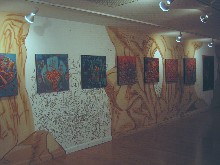
Paul Santoleri took a bunch of drawings, plopped them up on the walls upstairs and downstairs at the Painted Bride, and then connected them, allowing their imagery to flow beyond the edges and unite in one glorious explosion of action from the first floor to the second and back again.
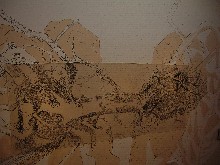 Transforming Escher’s hard-edged Mobian space into decaying organic, biological fantasies, dense grottos and paths that suggest a map of Middle Earth, Santoleri deftly shifts from tiny scale to mural scale. Making all those marks, covering all that space in less than two weeks is also amazing. And coming out with something not just coherent but energetic and beautiful and all-encompassing –well!!!
Transforming Escher’s hard-edged Mobian space into decaying organic, biological fantasies, dense grottos and paths that suggest a map of Middle Earth, Santoleri deftly shifts from tiny scale to mural scale. Making all those marks, covering all that space in less than two weeks is also amazing. And coming out with something not just coherent but energetic and beautiful and all-encompassing –well!!!
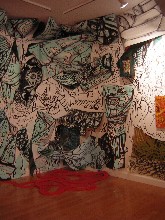 The work even spreads across the floor, and goes three-D on the top floor. It offers nodules of densely figurative riffs of imagination –little cities, groves of plant life– and nodules of electric mark-making that’s ultimately unreadable but that suggests force-fields of matter, almost knowable yet elusive.
The work even spreads across the floor, and goes three-D on the top floor. It offers nodules of densely figurative riffs of imagination –little cities, groves of plant life– and nodules of electric mark-making that’s ultimately unreadable but that suggests force-fields of matter, almost knowable yet elusive.
As in the paintings and drawings, the wall drawings dissolve and focus with alarming rapidity, twisting to create all at once a teeming universe, a cosmos expanding without limits as it shrinks down into the gravity pull of a black hole.
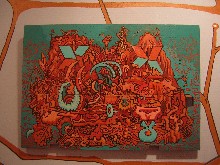 Santoleri, who is one of the city’s great muralists, in this less public sphere shows where the wild things are. Gotta see it and gotta love it.
Santoleri, who is one of the city’s great muralists, in this less public sphere shows where the wild things are. Gotta see it and gotta love it.
(By the way, Roberta wrote the excellent catalog essay. She didn’t have to pay me to mention this.)
Paradise
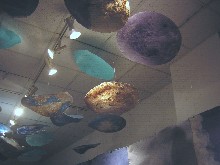 A cast -paper installation, “Paradise,” by Yukie Kobayashi fills the back gallery at Nexus. Flat clouds, looking like lily pads, float above, and long scroll-like sheets circle the space, creating a floaty room. In the center, a Garden of Eden, with apples of ceramic and pages from a bible hung from a lacy tree while a lacy crocodile/snake menaced.
A cast -paper installation, “Paradise,” by Yukie Kobayashi fills the back gallery at Nexus. Flat clouds, looking like lily pads, float above, and long scroll-like sheets circle the space, creating a floaty room. In the center, a Garden of Eden, with apples of ceramic and pages from a bible hung from a lacy tree while a lacy crocodile/snake menaced.
 The ephemeral nature of all this material got me thinking about how ephemeral the myths of our culture are in the larger scheme of things. The croc and the clouds stole the show for me, but the tree and the apples were also pretty nice.
The ephemeral nature of all this material got me thinking about how ephemeral the myths of our culture are in the larger scheme of things. The croc and the clouds stole the show for me, but the tree and the apples were also pretty nice.
Moonshadows
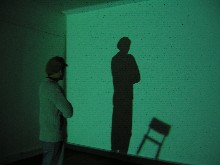 Drizzle had a projection by Kenya Nakazawa of silhouettes called “Memories of a Space.” The Japanese artist was in the U.S. on a three-month visa and contacted the gallery, so it was a let’s-put-on-a-show moment between him and gallery director Andrew Chew. Appropriately enough the projection came from a beat-up suitcase, opened wide on the floor.
Drizzle had a projection by Kenya Nakazawa of silhouettes called “Memories of a Space.” The Japanese artist was in the U.S. on a three-month visa and contacted the gallery, so it was a let’s-put-on-a-show moment between him and gallery director Andrew Chew. Appropriately enough the projection came from a beat-up suitcase, opened wide on the floor.
The imagery was spare–a figure, a chair, a tree, another figure, all in silhouette and all suggesting isolation. Gallery goers can break through the isolation by adding their own silhouettes as they walk through the space. Ultimately, though, it’s a false sense of company.
Mouse-zilla
At Carbon 14, Chris Bergen’s “Mice,” (see student post), which was still up last week when I stopped by, worked so well because the scale of the projection turned the dollhouse furniture of the mouse livingroom into human scale. Even mouse crunching sounds got the blow-up treatment. The mice in the projection were huge and very busy getting not much accomplished. I did so identify at the same time that I was repelled.









